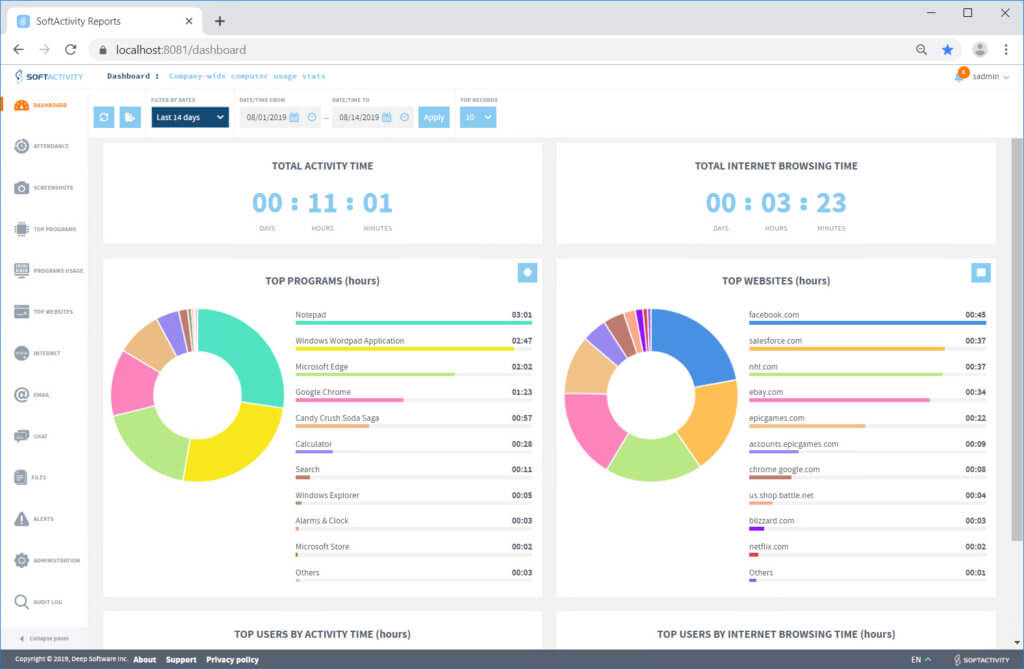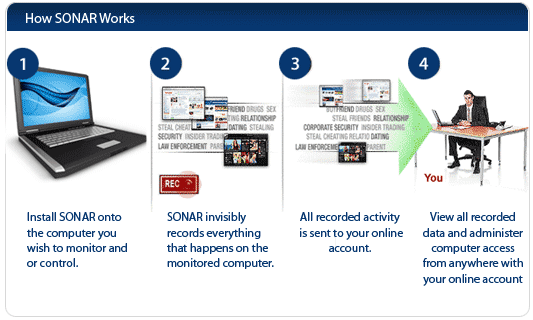The term"employee-monitoring software" is used to refer to an application that businesses employ to track their employees' activities while they work. It allows employers the ability to collect data on a variety of aspects related to employee behavior. This includes Internet usage and application usage as well as screenshots, keystrokes and other information. The main purpose of employee tracking software is to increase productivity, enforce compliance with the company's policies, safeguard sensitive information, and address security concerns. There are many factors to think about when selecting an the best employee monitoring software. Take note of these crucial aspects: Features. Find the features you require in line with the needs of your company. Common features include monitoring activity, blocking websites, keystroke logs, application usage tracking as well as email monitoring and reports generation. Make sure you only use features that are relevant to your monitoring needs.
Compliance and Privacy - Make sure that the software complies to ethical and legal standards in relation to employee monitoring. Make sure you are aware of the laws and regulations in your state. This includes privacy and data protection laws. Consider software that offers clear and customizable choices to ensure employee privacy.
User-Friendliness: Consider the software’s usability and accessibility. A user interface that is easy to use and a straightforward installation process can save you time and make it easier to implement. It is recommended to look for dashboards that are customizable and reporting tools that permit you to easily analyze the data you have taken.
Integrity and compatibility- Make sure whether the program works with your current IT infrastructure, which includes the operating system and email client, as well as the project management tool, and collaboration platforms. Compatibility is key to ensuring uninterrupted monitoring, and without disrupting your day-today activities.
Data Security- Assess the security features of the software to safeguard the data it collects. Access controls as well as encryption and secure storage of data, and conformity to industry-standard security protocols are crucial. Check the security practices of the software.
Scalability: Think about how the software will scale to meet the requirements of your growing company. If you are planning to expand your workforce or opening new locations, you should choose a software that is able to easily scale to meet your evolving needs.
Reporting and Analytics - Look at the capabilities of the software for reports. Features that provide comprehensive insights into the productivity of employees, their time management, and other trends are crucial to consider. Customized analytics and reports can assist you in making informed decisions and identify improvements.
Customer Support- Evaluate the quality of support offered by the software vendor. Find out how responsive, available and the amount of technical assistance they offer. Good customer support ensures prompt help when issues occur.
Cost- Take a look at the pricing structure for the program. Is it a single payment, a subscription, or dependent on usage? Understand the pricing model that includes any additional charges for support upgrades and other features. Budget your purchase in relation to the features and value provided.
Transparency and Communication With Employees Communication with employees should be clear and transparency when working with employees in relation to monitoring software. Be clear about the goal as well as the scope and expectations regarding the monitoring. Be sure they are aware of their privacy rights and address any questions.
These aspects will allow you to make an informed decision about the employee monitoring software you pick. Follow the top rated employee monitoring services for website advice.

What Are The Features Of Employee Monitoring Software And What Are The Differences Between Them?
Software designed to monitor employee activity has numerous features that can be used to monitor and analyze employee behavior. The features that are available may differ among different software options However, here are a few common features found in the software for monitoring employees: Activity Monitoring- This feature captures and records the activities of employees such as websites visited, applications used along with the file types accessed, as well as time spent in each job. It gives a complete summary of the way employees spend their time working.
Keystroke Logging Keystroke logs record every single keystroke entered by employees. It can detect productivity bottlenecks and also identify unauthorized actions and collect evidence to aid investigations.
Screenshots and Screen Recording- Some software captures screenshots of computer screens of employees regularly or record their screens in real-time. This can be helpful to monitor productivity, verifying compliance, or troubleshooting issues.
Internet Usage Tracking- This feature monitors employees' internet activities, such as the websites they visit, searches and downloads. This feature assists in identifying excessive browsing that is not related to work, potential security risks, and policy violations.
Application Usage Tracking- This feature tracks the applications that are used during working hours by employees. It lets you know which applications are the most popular. It can also help to identify inappropriate or illegal application usage.
Email Monitoring – Email monitoring allows employers monitor employee emails to include sent and received messages as well email content. It ensures compliance with corporate policies, prevents leaks of data, investigates any suspicious activity, and assists to ensure compliance.
File and Document Tracking This feature tracks access to files and changes in the file. It helps safeguard sensitive data by monitoring document collaboration and monitoring compliance with data protection guidelines.
Remote Monitoring is a function which allows employers to keep track of their employees, regardless of whether they work from afar or at various places. Employers can keep track of employees' activities and ensure their productivity, regardless of the location they're physically.
Productivity Analysis Software for monitoring employees comes with the ability to analyze productivity. These features give insights into employee patterns of work, their time allotment and productivity levels. These analyses can help to determine areas of improvement and help to optimize workflow.
Reporting and Analytics - The robust features for analytics and reporting generate detailed reports based on the data that is collected. These reports provide valuable insight into the performance of employees as well as resource allocation and time management.
Software solutions that provide policies and compliance features can assist in ensuring compliance to company and industry guidelines and rules. Employers can establish and enforce policies related to acceptable use of computers as well as internet access and security of data.
Alerts & Notifications - Alerts & notifications alert employers and managers of certain activities and events. They can be used to notify you of any suspect behavior, for example, excessive internet usage or attempts to access restricted sites.
Be conscious that various employee monitoring systems can have a variety of functions and features. Consider features that will assist you in reaching your goals for monitoring as well as ensuring compliance with ethical and legal standards of your area of operation. Have a look at the top rated time tracking monitoring services for more recommendations.

What Software Is Used To Monitor Employee Performance? How Does It Comply With The Compliance And Privacy Law?
Privacy and compliance laws are crucial to the use of employee monitoring software. Although the specific legal requirements may differ based on jurisdiction, there are a few common ways employee monitoring software adheres compliance and privacy law. Consent & NoticeMany areas require employees to provide an informed consent and receiving prior notice of any surveillance activity. The software for monitoring employees includes tools to assist employers in communicating the policies of their monitoring clearly to staff. This might include sending written notices, obtaining consent from consent forms or preparing an employee handbook that outlines monitoring procedures.
Transparent Monitoring Policies- Employee monitoring tools help promote transparency. They make sure that employees know what kinds of information is being gathered and why, as in the scope of monitoring. Employees can better know their rights to privacy and the limits of monitoring if policies are clearly and thorough.
Data minimization - In order to be in compliance with privacy laws and employ monitoring software, a process of reduction is commonly used. It means only the necessary data is collected and retained as unnecessary or irrelevant data is avoided. The software helps ensure compliance by restricting the information stored to only that which is necessary for monitoring.
Anonymization and Aggregation: Some software for monitoring employees anonymizes data, or aggregates it to protect employee privacy. Anonymization erases all personal identifiable information (PII) and is unable to link data to individuals. The aggregated data is a combination of multiple employees' data in order to gather insights at the group level, without identifying specific individuals.
Secure data storage and encryption Employee monitoring software puts the highest priority on the security of data. It uses secure data storage techniques and encryption to protect collected information from unauthorized access, breach, or data that is accidentally divulged. This also includes safeguarding data on the move and at stationary.
Access Controls with Restricted Rights In order to ensure compliance, the majority of employee monitoring programs offer access controls and restricted rights. Employers can restrict the number of authorized users that can access monitoring data for instance HR staff or designated administrators.
Employee Rights and Remedies The protection of the rights of employees is crucial for ensuring that they are in compliance with privacy and compliance laws. Most employee monitoring programs contain features that allow employees to look over their personal data as well as make corrections and submit complaints. The software gives employees the ability to pursue recourse in the case of privacy violation and to make use of their rights.
Compliance with Data Protection Regulations – The employee monitoring software is built to comply with the applicable laws on data protection including the General Data Protection Regulations in Europe or the California Consumer Privacy Acts in America. This includes implementing measures to protect personal data and honor the rights of the data subject.
Apart from employing tools for monitoring employees, organizations should consult legal experts and stay current regarding the latest laws and regulations in their area of responsibility. Compliance and privacy laws require a comprehensive strategy that includes more than just software. It also calls for clear policies, regular compliance monitoring, and employee education. Take a look at the most popular time tracking monitoring software for website recommendations.
